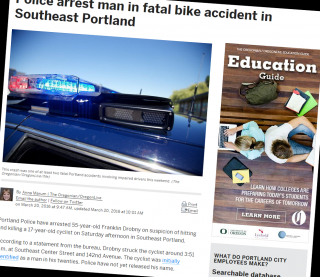“Accident”? “Crash”? “Collision”?
The Oregonian’s director of news says the newspaper’s unofficial practice has been, for years, to avoid “accident” in the absence of information because that word suggests that a traffic incident was unpreventable.
But the copy desk chief says the opposite: his preference is to go with “accident” in the absence of information because he feels “crash” and “collision” are favored by “activists” and the newspaper needs to remain neutral.
Reporters, meanwhile, don’t seem to be sure what to do. Last week, a business reporter was taking her turn on a weekend cops shift when an allegedly drunk driver killed a 17-year-old; her report described this as a “bike accident.” After a local lawyer emailed her to suggest different phrasing, she first described the word choice as “fine” based on the advice of one editor, then later apologized based on the advice of a different editor.
This week, a different reporter initially used “accident” after a different allegedly drunk driver who had been driving the wrong way on McLoughlin Boulevard at 1:30 a.m. turned around and collided her car with another man’s, sending him to the hospital. After another email from the lawyer, Scott Kocher, the second reporter agreed to change to “crash.”
“A lot of times when you’re talking about transportation collisions, there’s elements that are preventable.”
— Therese Bottomly, The Oregonian
After hearing from Kocher about these exchanges, we decided to try to get clarification on The Oregonian’s policy. That wasn’t easy, though. Asked who runs the newspaper’s copy desk (the traditional decision-maker on style issues) the paper’s transportation reporter said he wasn’t sure.
Our first stop was Therese Bottomly, the longtime managing editor of The Oregonian/OregonLive and a former copy editor herself.
“We typically try to avoid ‘accident,'” Bottomly, whose current title is director of news, said in an interview Thursday. “‘Accident’ to me, you could interpret it as being entirely unpreventable. And a lot of times when you’re talking about transportation collisions, there’s elements that are preventable.”
“That’s just been our practice for as long as I can remember,” she said. But Bottomly said different word choices sometimes fall through the cracks because the use of “collision” or “crash” is only a practice, not an official rule at the paper as spelled out by its stylebook.
“I don’t think it’s actually in our Oregonian stylebook,” Bottomly said. “That’s something that the copy desk keeps.”
Bottomly said the newspaper has a style committee that has “officially ruled on hundreds of things,” but she wasn’t sure who sits on it these days.
On Monday, I got ahold of Jake Arnold, production leader at The Oregonian/OregonLive and the de facto copy desk chief. He told me the same thing Bottomly had: the Associated Press style guide offers no guidance on the question, and The Oregonian’s internal stylebook doesn’t either.
“Our general feeling is we try to use the most descriptive words possible,” Arnold said. “Often ‘crash’ can be a more descriptive word than ‘accident.’ … ‘Crash’ is also a more value-loaded word. Generally ‘the accident’ implies no fault.”
“The two words would have been interchangeable 20 years ago. Now lawyers have decided that this means that and that means that. To some it does, to others it doesn’t.”
— Jake Arnold, The Oregonian
Arnold said that because the newspaper can’t be sure who was at fault in an incident, “we lean toward ‘accident.'”
I asked why the newspaper would want to presume that there was no fault if it does not yet know whether there was no fault.
“An accident is something that happened, and it can either mean no fault or it can mean we don’t know who’s at fault,” Arnold said. “Crash has more of a presumption of someone is to blame. … As a newspaper we are not in the practice of laying blame.”
“Language is evolving,” Arnold continued. “The two words would have been interchangeable 20 years ago. Now lawyers have decided that this means that and that means that. To some it does, to others it doesn’t.”
I asked about Bottomly’s notion that “accident” suggests that there was nothing someone could have done to prevent a collision. “That tends to be a more activist view of the meaning of the word ‘accident,’ Arnold said. “I don’t think the general population lays much meaning on the word.”
Ultimately, Arnold said, different Oregonian employees will differ on precisely what words mean.
“It’s why we put things in the style guide,” he said. “Therese has a background as a copy editor, and so it would not surprise me at all if that is part of her foundation of understanding and that she has instructed her reporters to act accordingly. The fact of the matter is that by the time it gets to the copy desk we don’t have a strong feeling one way or the other. If the reporter types ‘accident,’ we probably go with ‘accident,’ and if the reporter types ‘crash,’ we probably go with ‘crash.'”
So what’s the process for putting something in a style guide?
“Generally some sort of issue gets raised, somebody says, ‘we have a question on this,'” Arnold said. “We kick it around the copy desk. talk to reporters, talk to experts.”
Under the paper’s traditional process, that would have led to a discussion and vote by a style committee of four to seven people. But years of staff cutbacks had made the committee defunct, he said.
“Really it’s just me monitoring it,” he said.
Read more stories in our Language Matters column archives.
— Michael Andersen, (503) 333-7824 – michael@bikeportland.org
BikePortland can’t survive without subscribers. It’s just $10 per month and you can sign up in a few minutes.
The post A look inside one newspaper’s thinking on crashes, accidents and collisions appeared first on BikePortland.org.
from Front Page – BikePortland.org http://ift.tt/1RA7mTb

No comments:
Post a Comment